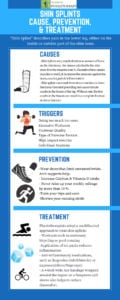"Shin Splint" is a generic term that describes pain in the lower leg, either on the medial (inside) or lateral (outside) side of the shin bone. This pain usually begins as a dull ache that can't be pinpointed to a particular spot; however it can be felt along the entire length of the region where the muscle attaches to the bone.
Initially, the exercises will generally feel pain only at the beginning and end of their workouts. But over a period of time, the discomfort becomes more intense causing pain throughout the workouts and starts even when the individual is not exercising like when getting out of bed.
When it's not shin splints
The following two conditions may present similar symptoms BUT are not ‘Shin Splints’:
Compartment Syndrome
Pain on the anterior (outside) part of the lower leg may be compartment syndrome which means swelling of muscles within a closed compartment, which creates pressure leading to pain. To diagnose this condition, special techniques are used to measure the amount of pressure. Symptoms of compartment syndrome include leg pain, unusual nerve sensations and at a later stage, muscle weakness.
Stress Fracture
Pain in the lower leg could also be a stress fracture (an incomplete crack in the bone), which is a far more serious injury than shin splints. A bone scan is the definitive tool for diagnosing a stress fracture. However, there are clues you can look for that will signal whether or not you should get a bone scan.
Press your fingertips along your shin, and if you can find a definite spot of sharp pain, it's a sign of a stress fracture; the pain of shin splints is more generalized.
Usually, stress fractures feel better in the morning because the bone is rested all night whereas Shin splints are worse in the morning because the soft tissue tightens overnight and the individual feels the pain in the morning when the tissue is stretched by the individual in an effort to stretch the muscles.
Shin splints will be most painful if an individual forcibly tries to lift the foot up at the ankle, however, if the foot is flexed and it hurts, it's probably shin splints. Also, a horizontal rather than vertical line of tenderness across the bone is typical of a stress fracture.
Causes of shin splints
The pain that originates due to shin splints results from an extreme amount of force on the shin bone and the tissues attached to the shin bone and to the muscles near it. The excessive force causes the muscles to swell and increases the pressure against the bone, leading to pain and inflammation.
Shin splints can also result from stress reactions to bone fractures. The constant pounding can cause minute cracks in the bones of the leg. The body can repair the cracks if given time to rest. However, if the body doesn’t get time to rest, the tiny cracks in the tissues can result in a complete fracture or a stress fracture
What triggers the risk of shin splints
The following activities increase the risk of shin splints:
Doing too much too soon
Often people with a lot of enthusiasm start an exercise program too aggressively. It is important to gradually progress in your running or conditioning program, allowing for adequate rest between the workouts.
Extensive Workouts
Overuse syndrome typically occurs when someone does too much and continually strains the muscles of the lower leg. Increasing your distance or intensity by more than 10% per week would make you a prime candidate for shin splints—especially if you don't cross-train to diversify your program.
Read: Sports injuries due to over-training, over-exertion or over-use
Footwear Quality
Quality running and cross-training shoes are designed to give the best anatomical support. If your shoes are broken down or old—even when the soles or top appear fine—then they have lost their ability to control the rotation of your foot and absorb shock. This "breakdown" usually occurs after 400-500 miles of wear.
Type of Exercise Terrain
Hard surfaces can cause and aggravate shin splints. The optimal surface for running and aerobics should absorb shocks, such as an all-purpose track or grassy surface.
High impact exercise
Running sprints, running uphill, jumping, and repetitive impact of exercises can all cause shin splints.
Read: How to prevent foot pain while running
Individual Anatomy
Fallen arches (flat feet), knocked or internally rotated knees, very high arches and over rotation of the foot are all prime causes of shin splints. An orthopedic physician, athletic trainer, or physical therapist can help identify mechanical problems and may prescribe orthotics (custom shoe inserts) as well as strengthening and stretching exercises.
Healing Time of shin splints
There is no quick cure for the treatment of shin splints. The healing process can take several weeks & in some cases, months. In order to allow the inflamed tissue to heal, it's recommended that the individual must stop running and exercises.
Prevention of Shin Splints
Change your shoes
Try switching to a shoe that limits unwanted twists. Arch supports can also help.
Boost Up your calcium and vitamin D intakes
Try 1,300 milligrams of calcium and 400 micrograms of D per day. Easy food sources are milk and yogurt.
Follow the 10 percent rule
Runners, never raise up your weekly mileage by more than 10 percent.
Train your hips and core
Strengthening these areas will make you a stronger runner, which improves foot strike and body mechanics.
Shorten your running stride
Doing this while increasing your foot strike cadence may help you generate better stride mechanics because you’ll be putting a lot less load on your feet, shins, knees, and on up the kinetic chain. Count your foot strikes on one side for 1 minute. A good number is 85 to 90 strikes of one foot per minute.
Treatment of Shin Splints
The physiotherapists adopt multifaceted approach mentioned below for treatment of Shin Splints:
- Workouts such as stationary bicycling or pool running: These will allow maintenance of cardiovascular fitness.
- Application of ice packs reduces inflammation.
- Anti-inflammatory medications, such as ibuprofen (Advil/Motrin) or naproxen(Aleve/Naprosyn), are also a central part of rehabilitation.
- A 4-inch wide Ace bandage wrapped around the region or a Neoprene calf sleeve also helps to reduce discomfort.
- Calf and anterior (front of) leg stretching and strengthening address the biomechanical problems discussed above and reduce pain.
Pay careful attention to selecting the correct running shoe based upon the foot type (flexible pronator vs. rigid supinator). This is extremely important. In selected cases, shoe inserts (orthotics) may be necessary.
Run only when symptoms have generally resolved (often about two weeks) and with several restrictions:
1. A level and soft terrain is the best.
2. Distance is limited to 50% of that tolerated preinjury.
3. Intensity (pace) is similarly cut by one-half.
4. Over a three- to six-week period, a gradual increase in distance is allowed.
5. Only then can a gradual increase in pace be attempted.
In case there is no or little improvement with the above-mentioned treatment steps/ exercises after a considerable time ( generally 3 months and more); the doctor can suggest surgical correction of the muscle.


